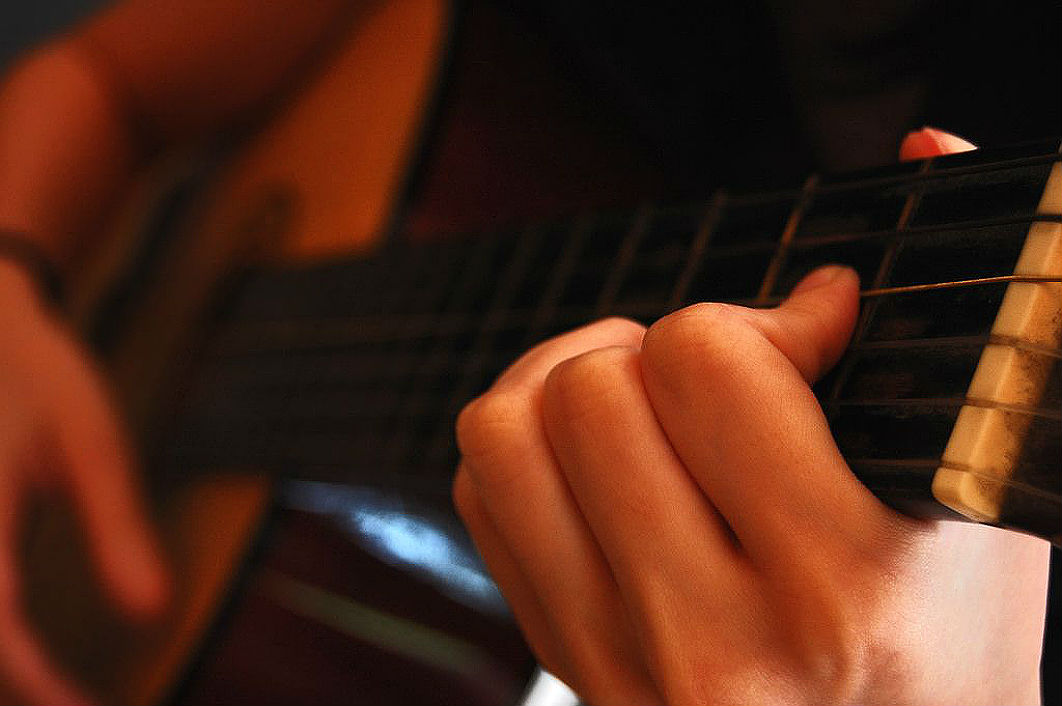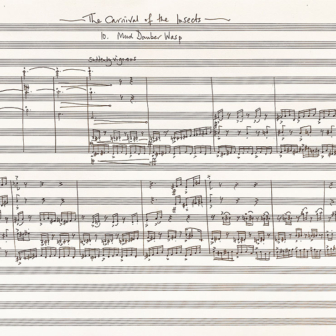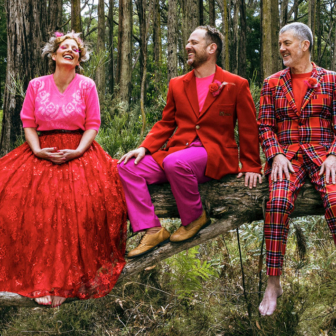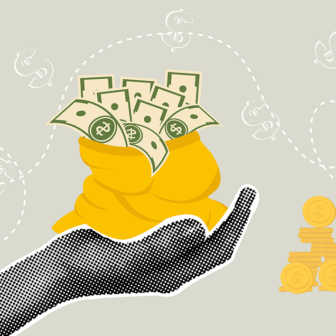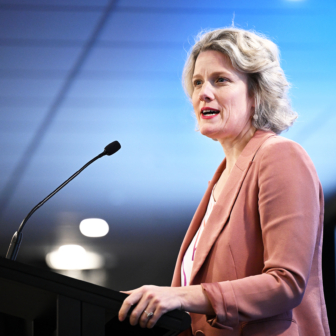I’m sitting in the basement of a building at the sleazy end of Melbourne’s King Street, feeling a bit nervous. I’m about to take part in a group music session, but I don’t play an instrument and the closest I usually come to singing in public is burying my voice in group renditions of “Happy Birthday.” Yet compared to the rest of the people in the room I don’t have a care in the world. The other six participants, all of them young, are homeless, at risk of homelessness or profoundly vulnerable in other ways. Only seventeen-year-olds Nina and Lucy are first-time participants like me, and they look as apprehensive as I feel.
To break the ice, music therapist Asami Koike asks us to introduce ourselves and nominate an artist we like whose name begins with the same first letter as our own. The others mostly choose performers I’ve never heard of, and I worry that my pick, Paul Kelly, will make me look even more out of place. But Susie, a slight young woman with lively eyes, short hair and a winning smile, surprises me by saying, “Cool, good choice,” and Conrad, solid and quiet, nods in agreement. The two of them are already holding acoustic guitars; Asami has one too, and Jess is seated at the keyboards, ready to play. Asami encourages the rest of us to pick a less demanding instrument from a selection of things for shaking or hitting that she’s spilled onto the table.
“Okay,” she says. “Let’s make some music. Susie, why don’t you choose something?” Susie hauls over a fat blue folder and begins leafing through. The folders, and there are several of them, are packed with plastic sleeves, each sleeve containing multiple copies of the lyrics and chord progressions for popular songs. Asami has collected hundreds of sheets to cover every possible taste in music.
Susie makes her selection and hands around the photocopies, and we crash our way through a rather sad ballad. I’m not familiar with the artist or the song, but the melody is easy enough and we make a surprisingly good fist of it. Asami’s strumming keeps the rest of us more or less in time and her singing helps us carry the tune. As we finish, a light ripple of laughter goes through the group, a sense of relief and release. No one is embarrassed. No one feels foolish. The song is a small triumph that binds us together.
Music therapy is a relatively new but growing profession. Like many new ways of doing things, it has its origins in wartime, when medical professionals began noticing the effect visiting music groups had on traumatised veterans. Music therapy is mostly used in clinical environments, often with the very old — as a therapy for dementia for example — and the very young, including in children’s hospitals as an aid to treatments, mental health and neurodevelopment. It is also used to help people with autism.
To date, though, it hasn’t often been used in community settings or as a way of helping teenagers and young adults. But Asami says common sense tells her that it has great potential. “If you think about it, adolescence and early adulthood are the times when music plays the most crucial role in our lives,” she says. “Music is the way young people express and explore identities.” Asami is putting her theory to the test at Frontyard Youth Services, where she runs this weekly drop-in session every Thursday afternoon and sees young people individually on other days.
Frontyard is part of one of Victoria’s oldest charities, Melbourne City Mission. It provides statewide services for vulnerable young people (aged twelve to twenty-five), particularly those who are homeless or at risk of becoming homeless. Every day, seven days a week, about thirty young people make their way through the door, some coming back for repeat visits, and a larger number seek help over the phone.
When they first make contact with Frontyard, most of them want urgent assistance with housing: maybe they’ve finally run out of couch-surfing options, maybe they’ve been kicked out of private rental accommodation or fallen out with their housemates. Often, they will have escaped a violent home and sometimes they are already sleeping rough. Frontyard staff do their best to find them a safe place to spend the night, but the best they can offer may be a bed in a dorm at a backpacker hostel or a seedy motel room. On any given day, more than 6000 young Victorians are homeless, yet the state has only fifteen dedicated youth refuges with a total of 107 beds between them.
Beyond a lack of accommodation, Frontyard’s clients generally have other complex needs. Homelessness is frequently tangled together with challenges like experiences of family violence, trauma inflicted in state care, mental illness, disability or learning difficulties, poor social skills, limited education, low self-esteem, and poverty and unemployment. Even with the best-trained and most sympathetic youth workers, a troubled kid is unlikely to be willing or able to lay this all out at the first meeting. So Frontyard strives to build trust and engagement through a range of free onsite services and activities. It offers a help-yourself, all-day breakfast, wi-fi, phone charging, showers and laundry facilities. It helps with practicalities like getting an ID card and registering for Youth Allowance, has its own college, and is co-located with an adolescent health clinic, a free legal service and a mental health team. Staff can help with finding a job or with improving personal relationships.
Then there’s music therapy, one of Frontyard’s newer and more innovative offerings. The program grew out of Asami’s postgraduate studies at the University of Melbourne, which were coming to an end in 2015. In the final semester of her Master of Music Therapy, she and other students were required to find a placement in an organisation that didn’t already offer music therapy. In other words, they had to approach an organisation and convince it to give music therapy a chance. Asami chose Frontyard, and staff there were happy to give it a try. By the end of her placement the results were so positive that management offered her a job, funded out of the untied donations that make up about a quarter of Frontyard’s budget.
Asami is a versatile and highly skilled musician. Along with vocals and guitar, she plays violin, piano, saxophone and drums. She’s also worked as a research assistant on a University of Melbourne study examining music therapy’s role in helping young people recovering from mental illness. Her ability to build rapport within our disparate little group is remarkable.
Crowded together in her basement music room, we work our way through songs by Adele, Bruno Mars and ABBA. “Dancing Queen” is the only song I know well (though it wouldn’t have been my choice) and, apart from Asami, most of us struggle with its rapid transitions from low to high notes. But no one really cares, and I even get a bit more ambitious on my tambourine, with a flourish on the line “Feel the beat from the tambourine, oh yeah…” I don’t think the other participants quite comprehend when I tell them afterwards that the song was a hit when I was thirteen — the mid 1970s is just too remote in time — but they humour me nonetheless.
One participant, Frankie, leaves after our first song to attend a meeting with a support worker, but not before swapping tips about hair colour. The newcomers, Nina and Lucy, are both noticeably more relaxed. “Do you come here every week?” Nina asks Susie. “Because if I know you are here too then it’ll be easier to come back again.” Quiet Conrad is also talking more, telling us how much the fingertips of his left hand are starting to hurt from pressing down the guitar strings to form chords. He looks lighter and makes more eye contact.
Before the group started, Asami had explained to me that promoting social connection was one of her three overall goals. “It is not about music as performance or about giving young people the skills to busk or to get into a music school,” she says. “It’s more about bringing people together.” She wants to give isolated young people a chance to work out who they are in a social context.
“Many young people who come to Frontyard have only a negative sense of self,” she says. “They think, I am homeless, I am in crisis.” Listening to, playing and talking about music enables young people to start building a more positive identity, the second of Asami’s three goals. “Often, they have little sense of who they are,” she says. “They don’t care about themselves and have no boundaries.” In determining the artists they like or hate, in forming opinions about whether they think a piece of music is good or bad, they begin to define themselves, and so put in place the building blocks of a more secure sense of identity. “Young people have such strong opinions about music, so if you can say you don’t like something, then your prefrontal cortex is working,” says Asami, referring to a part of the brain that plays a crucial role in developing personality, complex planning and impulse control, and ordering emotional responses.
This links to Asami’s third aim of using music to regulate the senses and provide emotional respite in an otherwise chaotic world. Towards the end of our group session I get a dramatic firsthand taste of how this works. We’ve just finished a rendition of Oasis’s “Don’t Look Back in Anger.” I couldn’t name the song, but I immediately recognise the tune and the lyrics (“And so, Sally can wait, she knows it’s too late as we’re walking on by.”) We’ve done a solid job with the song, despite its tricky rhythms, and the mood in the room is upbeat but mellow. There is a sense that we have achieved something together.
Then, just as it looks like the session is drawing to a natural close, three new participants burst in, filling the room with backpacks and duffel bags bursting at the seams. Bernie and Helen are regulars at Frontyard, and know most of the others in the room, greeting them loudly. The third young woman, Christie, is a new arrival and has just spent her first night in one of Melbourne City Mission’s four youth refuges, being lucky enough to secure the one bed that is kept vacant for last-minute emergencies. All of them are eating doughnuts, all of them are hyped up and on edge. “This is the last time you’ll see us, Miss,” Bernie calls out to Asami. “We’re going to Brisbane tomorrow!” Susie asks why. “’Cause I got bashed on Saturday night,” she responds, as if this is explanation enough. “Who’s he?” Bernie then demands, pointing at me. I explain that I’m writing about housing and homelessness.
Bernie doesn’t seem to care about my answer or my presence, but her arrival has been like a sudden change in the weather. The energy in the room is completely different, almost electric. I feel like the situation is getting out of hand, and that the progress Asami has made with the rest of the group is at risk of being undone. I expect her to wrap things up quickly to limit the damage, but she does the opposite, quietly suggesting that the three late arrivals join us in another song. She encourages Bernie to choose from the folders. “Nah, Miss, I don’t want to play, I just came to say goodbye,” she says. Bernie is still standing, jiggling from one foot to the other, her tall frame dominating the room. Susie chooses instead and we get stuck into another ballad. Despite themselves, Bernie, Helen and Christie soon join in. When the song ends, Bernie wants another, and then a third. By the end of the session she is calmer and more focused, and is sitting down, joining us in the circle of chairs.
“With the young people who come to Frontyard, often their brain is over-firing, or it is not firing at all,” Asami tells me later. Even playing with one hand on a drum regulates breathing and heartrate and brings participants into emotional sync with others in the group. “The feeling of being in time with a whole group means that everyone is there, everyone is present,” she says. “The effect is both visceral and cognitive.”
While I see that sensory regulation can be almost immediate, Asami tells me that it can take a year or more of incremental steps to achieve longer-term outcomes. A young person may initially be averse to seeing the nurse at Frontyard’s health clinic, for example, but feel more confident to do so after a few weeks of attending music therapy.
While the Thursday event I attend is a drop-in session, open to all, Asami’s one-on-one work proceeds a bit differently. “Some just want to learn guitar, they don’t want to talk and they don’t want to look at you,” she says. “They have lost so much trust with all the authority figures in their life.” But after about fifteen minutes, that generally changes. “They must feel calm and must feel safe to start talking,” she says. “If you start to play music together, then I’m no longer a therapist, I’m a band member. It breaks down the power dynamic.”
Bernie has participated in these one-on-one sessions, and Asami tells me that the first time she came she said, “Nothing fucking works, Asami, so I’m just going to give this a go.” She would use two fingers to pick out notes on the keyboard for long stretches of time, apparently completely at random, with no evidence of melody or rhythm. Asami interprets Bernie’s improvisation as an expression of the intense isolation she feels. She says that music therapy has really softened Bernie, whom she describes as both “intense” and “maternal,” quick to share whatever she has, and often taking others, like Helen and Christie, under her wing. Conrad, too, has been doing individual sessions. I am amazed when Asami tells me that this placid, friendly young man has anger problems and has been the subject of intervention orders by his parents.
At the end of our group session, Nina asks Asami if she can stay behind for a minute and talk to her privately. I sense that this is another opportunity, the moment at which a troubled young person reaches out, revealing more of her story and her needs.
As Asami reminds me, music is symbolic, and we often use it when words are unavailable or inadequate to express our feelings or meet the emotion of a situation. “That’s why we play music at weddings and funerals and before sending soldiers off to war,” she says. Music can lift young people out of the hole they are in, and help them to see beyond the rim of their immediate crisis, connect with others and build trust. As the odd man out in our group, I felt included, with the young participants doing their best to put me at ease and make me welcome.
“What is so interesting is that everyone is so generous,” says Asami. “They step up and take responsibility, as if there is a real need to prove that they are not just taking, but want to give back.” ●
Names have been changed to protect the privacy of participants.
